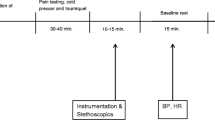Abstract
Six female subjects who were between 31 and 44 years of age attended a premenstrual syndrome (PMS) clinic and participated in a group therapy program designed to alleviate their premenstrual symptoms. Rational-emotive therapy (RET) and relaxation training were offered in addition to ongoing progesterone treatment in an effort to alleviate severe psychological symptoms thought to be occasioned by the hormonal changes occurring during the premenstrual week. Pre-treatment assessments were carried out using Moos' Menstrual Distress Questionnaire, Broadbent's Cognitive Failures Questionnaire, and Eysenck's Personality Questionnaire. Additionally, levels of self-reported psychological and physical menstrual distress symptoms were estimated by the subjects at each premenstruum throughout the ten-week therapy program. At the end of the ten week therapy program hormone treatment was discontinued. Significant pre-test to post-test differences were found in a number of psychological and physical symptoms of menstrual distress, in cognitive functioning and neuroticism, following the combined group treatment. Improvements in psychological functioning during premenstruum were observed at a one-year follow-up. RET and relaxation together with hormonal therapy produced a substantial reduction in PMS symptoms in comparison with drug treatment alone.
Similar content being viewed by others
References
Beck, A.T., Rush, A.J., Shaw, B.F. & Emery, G. (1979).Cognitive therapy of depression, New York: Guilford Press.
Bloch, D. (1978). Sex education practices of mothers.Journal of Sex Education Therapy, 4, 7–12.
Bernard, M.E., Kratochwill, T.R. & Keefauver, L.W. (1983). The effects of rational-emotive therapy and self-instructional training on chronic hairpulling.Cognitive Therapy and Research, 7, 273–280.
Broadbent, D.E., Cooper, P.F., Fitzgerald, P. & Parkes, K.R. (1982). The Cognitive Failures Questionnaire, (CFQ) and its correlates.British Journal of Clinical Psychology, 21, 1–16.
Brooks, J., Ruble, D. & Clark, A. (1977). College women's attitudes and expectations concerning menstrual-related changes.Psychosomatic Medicine, 39, 288–298.
Clarke, A.E. & Ruble, D.N. (1978). Young adolescents beliefs concerning menstruation.Child Development, 49, 231–234.
Coppen, A. (1965). The prevalence of menstrual disorders in psychiatric patients.British Journal of Psychiatry, 111, 155–167.
Coppen, A. & Kessel, N. (1963). Menstruation and personality.British Journal of Psychiatry, 109, 711–721.
Dalton, K. (1978)Once a month. Fontana Paperbacks.
Dennerstein, L. & Burrows, G.D. (1979). Affect and the menstrual cycle.Journal of Affective Disorders, 1, 77–92.
Dennerstein, L. & Burrows, G.D. (1981). Understanding premenstrual tension,Patient Management, 47–51.
Ellis, A. (1962)Reason and emotion in psychotherapy. New York: Lyle Stuart.
Ellis, A. (1973).Humanistic psychotherapy: The rational-emotive approach. New York: McGraw-Hill.
Ellis, A. (1979). The theory of rational-emotive therapy. In A. Ellis & J.M. Whiteley (eds),Theoretical and empirical foundations of rational-emotive therapy, Monterey, CA: Brooks/Cole.
Ellis, A. & Grieger, R.M., (eds) (1977).Handbook of rational-emotive therapy. New York: Springer.
Ellis, A. & Harper, R. (1975).A new guide to rational living. Hollywood, CA: Willshire Books.
Eysenck, H.J. & Eysenck, S.B.G. (1975).Manual of the Eysenck personality questionnaire. London: Hodder and Stoughton.
Frank, R.T. (1931). The hormonal causes of premenstrual tension.Archives of Neurological Psychiatry, 26, 1053–1057.
Grant, C. & Pryse-Davies, J. (1968). Effects of oral contraceptives on depressive mood changes and endometrial monamine oxidase and phosphates.British Medical Journal, 28, 777–780.
Jacobsen, E. (1942).You must relax. New York: McGraw-Hill.
Koff, E., Rierdan, J. & Sheingold, K. (1982). Memories of menarche: age, preparation, and prior knowledge as determinants of initial menstrual experience.Journal of Youth and Adolescence, 11, 1–5.
Meichenbaum, D. (1977).Cognitive-behavior modification. New York: Plenum Press.
Moos, R. (1969). The development of a menstrual distress questionnaire.Psychosomatic Medicine, 30, 853–867.
Morse, C.A. & Dennerstein, L. (1984a). Thinking, feelings, and symptoms.Patient Management, 8, 99–103.
Morse, C.A., Dennerstein, L. & Farrell, E. (1984b). Menstrual-menopause disorders: a multidisciplinary approach.Patient Management, 8, 113–121.
Rees, L. (1953). The premenstrual tension syndrome and its treatment.British Medical Journal, 1, 1014–1016.
Sampson, G.A. (1979). Premenstrual syndrome: a double-blind controlled trial of progesterone and placebo.British Journal of Psychiatry, 135, 209–215.
Shader, R.F. & Harmatz, J.S. (1975). Molindone: A pilot evaluation of the premenstruum.Current Therapeutic Research, 1975,17, 403–406.
Watts, S., Dennerstein, L. & Hone, D.J. (1980). The Premenstrual syndrome.Journal of Affective Disorders, 2, 257–266.
Wittkower, E. & Wilson, A.T.M. (1940). Dysmennorhoea and sterility: Personal studies.British Medical Journal, 2, 586–590.
Author information
Authors and Affiliations
Rights and permissions
About this article
Cite this article
Morse, C., Bernard, M.E. & Dennerstein, L. The effects of rational-emotive therapy and relaxation training on premenstrual syndrome: A preliminary study. J Rational-Emot Cognitive-Behav Ther 7, 98–110 (1989). https://doi.org/10.1007/BF01246508
Issue Date:
DOI: https://doi.org/10.1007/BF01246508




